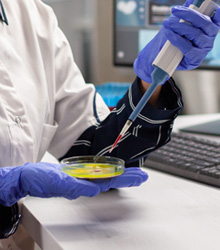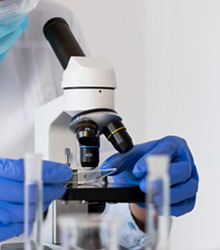DNA Genetic Transcriptions
- Home
- DNA Genetic Transcriptions


DNA Genetic Transcriptions
Gene Editing & Genetic Modification of Stem Cells
In our laboratory, we utilise DNA transcription in the specialized field of Gene therapy.
Gene Therapy
Is a technique that involves modifying a patient's genes to treat or cure a disease, with the goal to correct or replace a defective or missing gene or, to introduce a new gene that can help the body fight disease.DNA Transcription
Is the process by which genetic information in Deoxyribonucleic Acid {DNA} is used to synthesize a complementary Ribonucleic Acid {RNA} molecule. During transcription, the DNA double helix is unwound and one of the strands is used as a template to synthesize a complementary RNA molecule. The RNA molecule is synthesized by the enzyme RNA Polymerase, which reads the template DNA strand and adds complementary RNA nucleotides one-by-one to the growing RNA Chain.The RNA polymerase enzyme recognizes a specific sequence of DNA called a promoter, which signals the start of a gene. The RNA polymerase binds to the promoter and begins transcribing the DNA sequence into RNA. The RNA molecule that is synthesized during transcription is complementary to the template DNA strand and identical in sequence to the other DNA strand, with the exception of replacing thymine (T) with uracil (U). Once the RNA molecule is synthesized, it detaches from the DNA template strand and the DNA double helix reforms. The newly synthesized RNA molecule can then go on to perform a variety of functions, including acting as a template for protein synthesis (translation) or functioning as a regulatory molecule in gene expression.
DNA transcription is used in our research and practice of Gene therapy to treat a range of medical conditions, including but not limited to Cancer, Pulmonary, Neurological Disorders, Autoimmune and Human Longevity Medical Conditions.
We are proud to be a leader in the field of regenerative medicine and are committed to advancing the science of stem cells and DNA.
Gene
Therapy
A scientific procedure that involves modifying a patient's genes to treat or cure a disease, with the goal to correct or replace a defective or missing gene or, to introduce a new gene that can help the body fight disease. Gene therapy involves several steps, including:
1) Identifying the gene that needs to be modified:
This may involve identifying a gene that is defective or missing, or identifying a new gene that can be introduced to help the body fight disease.2) Selecting a delivery method:
Gene therapy requires a way to deliver the modified or new gene to the target cells. There are several methods for delivering genes, including viral vectors, which are modified viruses that can deliver genes to cells, and non-viral methods, such as electroporation, which involves using an electrical field to introduce genes into cells.3) Administering the gene therapy:
The modified or new gene is introduced into the patient's cells using the selected delivery method.4) Monitoring the patient's response:
After the gene therapy is administered, the patient is monitored to determine the effectiveness of the treatment and to monitor for any side effects.Gene Therapy
DNA Transcription
The process by which genetic material or information in Deoxyribonucleic Acid {DNA} is used to synthesize a complementary Ribonucleic Acid {RNA} molecule.
Gene therapy has been used to treat a variety of diseases, including:
1) Inherited disorders:
Gene therapy can be used to correct or replace defective genes that cause inherited disorders, such as cystic fibrosis, sickle cell disease, and hemophilia.2) Cancer:
Gene therapy can be used to modify immune cells to better target cancer cells or to introduce genes that can help kill cancer cells.3) Cardiovascular disease:
Gene therapy can be used to introduce genes that can help repair damaged blood vessels or to stimulate the growth of new blood vessels.4) Neurological disorders:
Gene therapy can be used to introduce genes that can produce missing or defective proteins in the brain or to modify cells to better target and treat neurological disorders.Overall, gene therapy is a promising approach to treating a wide range of diseases and has the potential to revolutionize the field of medicine. Currently, more in-depth research is being accomplished to determine the long-term safety and effectiveness of gene therapy, and to develop new delivery methods that can effectively target specific cells and tissues.
Translational Research
Involves Several Stages
Basic Scientific Research
This involves conducting laboratory-based studies to better understand the underlying mechanisms of disease and identify potential targets for therapy.


Preclinical & Clinical Research Trials
Preclinical involves testing potential therapies in-vitro for efficacy. Clinical involves testing potential therapies in human subjects to determine safety and efficacy.
Implementation
This involves implementing successful therapies into clinical practice and monitoring their effectiveness in the real world.






